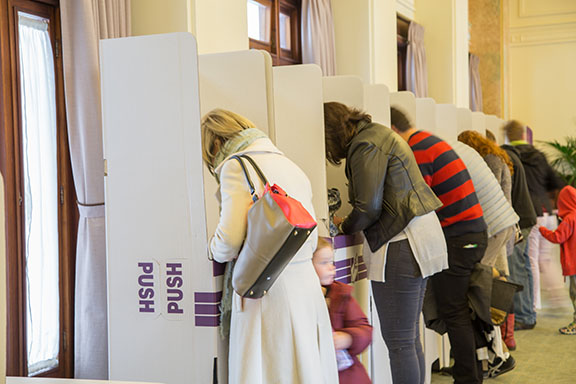You voted, ate your democracy sausage and watched as Scott Morrison was elected as prime minister. Australian politics never stops – Let’s delve in.
Election morning update
This morning the Coalition have won 75 seats, one away from the magic target to form majority government. Labor have won 65 seats with five seats still in play.
The Liberal Party lead the seats of Chisholm and Bass in Victoria and Tasmania respectively and the Labor Party lead Cowan in Western Australia, Lilley in Queensland and Macquarie in New South Wales.
In Bass Liberal candidate Bridget Archer leads Labor Party’s Ross Hart on preference count by 50.3 percent to 49.7 after 85.8 percent of the vote. Even after facing negative headlines throughout the campaign Liberal candidate Gladys Liu leads in Chisholm. After 77 percent of the vote counted Liu leads 50.4 percent to 49.6 percent against her Labor opponent Jennifer Yang.
In the seat of Macquarie it can’t get much closer. The preference count is 50 percent each with Liberal candidate Sarah Richards leading by 50 votes. When the Australian Electoral Commission said every vote counts they meant it.
Changing seats
As of Tuesday 21 May, seven electorates have changed members. The Liberal Party have gained four seats, Labor one and two Independents have picked up two.
The Labor Party were hoping to pick up seats in Victoria, New South Wales [NSW] and Queensland [QLD] but were only able to pick up Gilmore in NSW. The Liberals fared a lot better picking up seats of Herbert AND Longman and Lindsay and Wentworth in NSW.
Speaking of Herbert, is was the most marginal set in the country after the 2016 election. Only 32 votes separated the two major parties but this time it was straight-forward. The Liberal Party won the seat with a swing of 7.6 percent.
Only six months after winning the seat of Wentworth, with a swing of almost 20 percent, Kerryn Phelps lost the seat to Liberal candidate David Sharma.
Positive and negative results for the Greens.
On election morning, Greens leader Richard Di Natale spoke to the ABC and the Greens were hoping to win the seat of Kooyong, Higgins and Macnamara. All three seats were held by their respective parties.
In Kooyong there was a swing against six percent swing against Josh Frydenberg but that still wasn’t enough. Frydenberg won 49 percent of first preference votes compared to Greens candidate Julian Burnside who won 21.4 percent.
There wasn’t much to be excited about in Higgins and Macamara either. Both Greens candidates in these seats will finish in third. In Higgins Jason Ball, Greens candidate won 22.7 percent of first preference votes, Liberal candidate Katie Allan won the seat, she achieved 47.8 percent of first preference votes.
But it wasn’t all bad new for the Greens. They did regain the regain the seat of Melbourne and had a 2.6 percent swing in the Senate. It is expected that all six Greens senators will regain their seats. Their primary vote was almost at 11 percent in each state in Australia.
Now that we are talking about the Senate, let’s look into the 2019 results.
In the Senate the Liberal Party won 13 seats with the ABC predicting they would win another four more. Labor won 12 seats and is expected to win one more. Not all senators were able to regain their seats. Derryn Hinch, Fraser Anning and Brian Burston will no longer be part of the Canberra bubble.
Positive news for the Nationals.
The National Party had a very good night on election night. The party were able to regain each of their seats. In the seat of Calare and Lyne in NSW there was a swing of 4.8 and 4.3 percent respectively towards the party.
Barnaby Joyce continued to show that he is not going anywhere after another landslide victory. Even after the negative headlines of the water buy back scheme, Joyce won with a 4.5 swing. After preference count he won 7.9 percent of the vote. After the positive result there was talk in the media including the Guardian that Joyce might recontest the National Party leadership, but senior members of the party have come out in support of leader Michael McCormack.
Deputy leader Bridget Mckenzie has put her full support behind McCormack.
“I will be backing Michael McCormack all the way – he led us to victory, he has been tireless and relentless,” she said.
Coal fire industry putting pressure on government.
After Morrison won the election, the coal fire industry are hoping the government will build new coal-fired power stations. The Coal Council of Australia chief executive Greg Evans released a statement on Saturday.
“While elections are about an array of issues, it is important to note in coal-related electorates in both NSW and Queensland, Labor members and candidates recorded strong swings against them,” he said.
Most of the coal mines in Australia are situated in three electorates. They all had big swings towards the Coalition. In Hunter there was a swing of 9.9 percent awing towards the Nationals, in Dawson there was 11.3 percent swing for the Liberals and in Capricornia there was a 10.7 perecent swing towards the Liberals.







